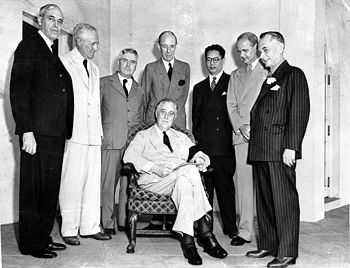Pacific War Council

The Pacific War Council was an inter-governmental body established in 1942 and intended to control the Allied war effort in the Pacific and Asian campaigns of World War II.
Following the establishment of the short-lived American-British-Dutch-Australian military command (ABDACOM) in January 1942, the governments of Australia, the Netherlands and New Zealand began to push Winston Churchill for an inter-governmental war council based in Washington D.C. The Far Eastern Council was established in London on February 9, with a corresponding staff council in Washington. However the smaller powers continued to push for a Washington-based body.
The Pacific War Council was formed in Washington on April 1, 1942, with a membership consisting of President Franklin D. Roosevelt, his key advisor Harry Hopkins, and representatives from Britain, China, Australia, New Zealand, the Netherlands and Canada. Representatives from India and the Philippines were later added.
Much of the impetus for the council was lost during the collapse of ABDACOM, in March and April. The council never had any direct operational control and any decisions it made were referred to the U.S.-British Combined Chiefs of Staff, which was also in Washington. Although there were relatively few U.S. forces in the Pacific in mid-1942, the sheer volume of matériel and forces controlled by the United States government soon gave it effective control of strategy in the Pacific War.
External links
- "Fact File : Formation of the Pacific War Council", BBC: WW2 People's War
- Pacific War Council Documents at the Franklin D. Roosevelt Presidential Museum and Library